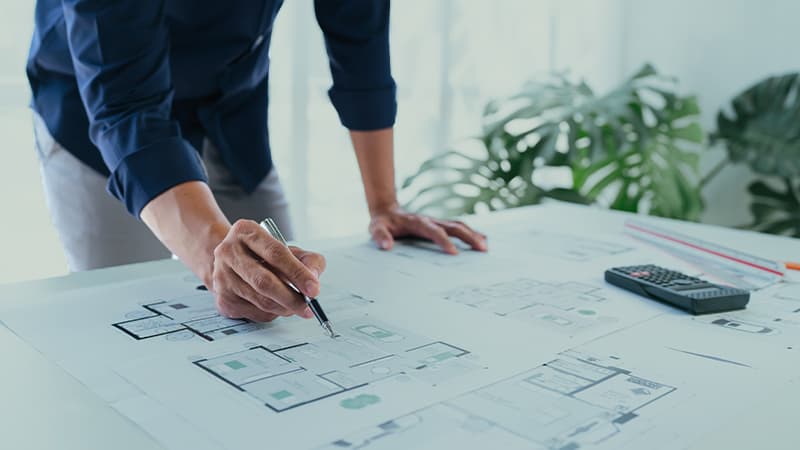Architect Recommended Tools for 3D Modeling
Architect Recommended Tools for 3D Modeling
Blog Article
Understanding the Diverse Job Paths Available for Aspiring Architect
As an ambitious Architect, you have a globe of profession paths waiting for you. Whether you're attracted to typical architecture or the nuances of sustainable style, there's a particular niche that aligns with your interests.
Conventional Design: Creating Structures and Frameworks
Conventional design focuses on creating structures and frameworks that mix capability with visual allure. As you discover this area, you'll value the detailed equilibrium in between kind and purpose. You'll learn to draw inspiration from historical designs, including elements like symmetry, materials, and craftsmanship. Your styles can mirror social heritage, showcasing neighborhood practices while fulfilling modern needs.
You'll create skills in drafting, model-making, and site evaluation, enabling you to imagine and communicate your concepts properly. Involving with customers, you'll need to recognize their vision and convert it into possible layouts.
In addition, developing codes and sustainability practices are important in your work, guaranteeing your structures are safe and eco-friendly. As you expand in your profession, you'll find possibilities in property, commercial, and even reconstruction tasks, each offering special challenges. Welcoming standard architecture leads the method for a fulfilling occupation that admires the past while forming the future.
Urban Preparation: Shaping Areas and Public Spaces
As a hopeful Architect, you can play a vital role as a city planner, changing how neighborhoods interact and operate. By utilizing area interaction approaches, you'll ensure that residents have a voice in shaping their setting. Plus, integrating lasting style concepts will assist develop spaces that not only satisfy today's needs however additionally protect the future.
Function of Urban Planners
While several might consider designers as the single visionaries behind buildings, city coordinators play an important function in forming the broader landscape of neighborhoods and public areas. They assess land usage, zoning laws, and community needs to produce lasting settings that boost lifestyle. By working together with different stakeholders, you'll assist make parks, transport systems, and houses that promote social interaction and access. Urban planners also concentrate on environmental factors to consider, guaranteeing that growths integrate environment-friendly spaces and support biodiversity. Your proficiency in spatial style and area characteristics permits you to visualize future development while preserving cultural heritage. In this essential role, you'll directly affect just how people experience their surroundings, making every task a chance for favorable modification.
Neighborhood Engagement Methods
Efficient area engagement strategies are important for metropolitan organizers to ensure that the voices of homeowners are listened to and valued in the preparation procedure. To foster meaningful dialogue, you must focus on open discussion forums and workshops where community members can share their concepts and concerns. By actively paying attention and including feedback, you'll produce spaces that reflect the community's needs, eventually leading to even more lasting and effective city atmospheres.
Lasting Design Concepts
When making metropolitan spaces, including lasting design concepts is important for creating settings that flourish both environmentally and socially. Think about integrating environment-friendly spaces, like gardens and parks, to enhance biodiversity and enhance air quality.
Creating with water conservation in mind is likewise key-- consider rainfall gardens and permeable surface areas to manage stormwater. Entailing community participants during the planning procedure assurances that the rooms you create fulfill their needs and motivate social communication. By embracing these concepts, you'll add to dynamic, lasting urban landscapes that profit every person.

Landscape Architecture: Creating Lasting Outside Environments
As you explore landscape style, you'll find important layout concepts that create practical and gorgeous outside rooms. Lasting practices play a crucial role in ensuring these atmospheres flourish while minimizing ecological impact. Plus, you'll discover a variety of profession possibilities that enable you to make a real distinction in exactly how individuals communicate with nature.
Layout Principles in Landscape
Recognizing design principles in landscape design is crucial for producing sustainable outdoor atmospheres that balance with nature. You'll need to contemplate elements like balance, scale, and percentage to ensure your styles feel cohesive and welcoming. Furthermore, pay interest to seasonal changes, designing with products that match the surroundings year-round.
Sustainable Practices Review
Sustainable techniques in landscape architecture not only focus on visual appeals however additionally focus on ecological health and wellness and source preservation. You can design spaces that promote soil health and wellness, such as making use of organic materials and practicing permaculture concepts. over at this website Inevitably, these practices guarantee your designs benefit both people and the atmosphere for years to come.
Job Opportunities Expedition
With a strong foundation in lasting practices, landscape style uses a variety of career courses that allow you to make a purposeful effect on the environment. Urban organizers typically collaborate with landscape engineers to create environment-friendly areas in city settings, boosting city livability. If you're passionate concerning education, take into consideration ending up being a landscape style teacher, motivating future generations.
Sustainable Layout: Concentrating On Eco-Friendly Practices
As you discover your career in design, embracing eco-friendly methods can establish you apart in a competitive area. Sustainable style concentrates on creating structures that minimize environmental influence while enhancing passenger health. By integrating eco-friendly materials, energy-efficient systems, and sustainable structure techniques, you'll contribute to a greener future.
Beginning by gaining understanding my sources of environment-friendly certifications like LEED or BREEAM, which can strengthen your credentials. Take into consideration exactly how all-natural light, ventilation, and thermal performance can optimize design. Work together with designers and ecological experts to introduce solutions that reduce waste and save sources.
Do not neglect the importance of community involvement-- appealing regional stakeholders can influence styles that balance with the setting. As customers significantly focus on sustainability, your knowledge in environment-friendly techniques will certainly not just bring in tasks but additionally accomplish your interest for liable style. Welcome this critical facet of the career, and see your job prosper.
Historical Preservation: Securing and Bring Back Cultural Heritage
While you commence on your building trip, think about the necessary function of historic preservation in keeping our social heritage. This field focuses on the protection and restoration of substantial structures, sites, and structures that inform the tales of our past. By engaging in historic conservation, you'll assist protect the architectural heritage that forms neighborhood identity.
As a historic conservation Architect, you'll evaluate historic relevance and assess the problem of structures. You'll function closely with chroniclers and guardians to guarantee genuine restoration methods are employed. This occupation path enables you to mix imagination with study, enabling you to make options that respect original products and craftsmanship.
Your work not only adds to sustainability by recycling existing buildings however additionally fosters a sense of pride within neighborhoods. Welcoming this course will assist you come to be a guardian of background, preserving the stories and visual appeals that enhance our lives.
Inside Style: Enhancing Indoor Spaces
Historical preservation and interior design both share a dedication to boosting the developed environment, but they concentrate on various facets. While historic preservation highlights preserving a framework's historic and cultural worth, indoor style absolutely nos in on optimizing indoor spaces for performance and appearances.
As an aspiring Architect, you'll discover that indoor style permits you to blend creative thinking with technological skills. You'll develop areas that not just look excellent yet additionally advertise convenience and efficiency. This field involves understanding exactly how light, color, and products engage within an area, impacting state of mind and functionality.
You'll deal with different jobs, from property homes to business workplaces, making certain that each setting fulfills the requirements of its passengers. By prioritizing user experience, you can transform interiors right into functional and motivating areas, making a substantial effect on how individuals engage with their surroundings. Welcome the chance to boost indoor atmospheres and shape the means individuals function and live.
Industrial Layout: Merging Performance With Looks
Industrial style plays an essential function in producing items that flawlessly mix aesthetics with functionality, ensuring that what you utilize everyday is not just visually attractive yet additionally useful. As an aspiring Architect, you could involve yourself in this field, focusing on creating every little next page thing from furniture to customer electronics. Your work entails comprehending user demands, materials, and producing processes, enabling you to create ingenious solutions that improve day-to-day experiences.
In industrial layout, you'll commonly team up with online marketers, producers, and designers, making certain that your layouts are not just lovely however likewise possible. This occupation path supplies a vibrant atmosphere where creativity fulfills usefulness, making it a satisfying option for architects interested in shaping the items of tomorrow.
Regularly Asked Questions
What Educational Accreditations Do I Need to Come To Be a Designer?
To become an engineer, you'll need a professional level in design, generally a Bachelor's or Master's. In addition, you'll need to complete a teaching fellowship and pass the Architect Registration Exam to practice legitimately.
Are There Qualification Demands for Different Building Profession Paths?
Yes, there're qualification demands for numerous architectural courses. Architect. You'll need to pass tests, total internships, and often pursue specialized training, relying on your chosen focus, like landscape style, metropolitan layout, or historic conservation
What Software Skills Are Vital for Architects Today?

Just How Can I Gain Practical Experience While Studying Style?
You can gain functional experience by interning at building firms, taking part in layout competitors, volunteering for community tasks, or teaming up with classmates on real-world tasks. These possibilities enhance your abilities and develop important connections in the sector.
What Work Opportunities Exist Outside Typical Architecture Firms?
You can check out numerous job chances outside traditional design companies, like city planning, indoor design, landscape design, construction monitoring, actual estate growth, or even functions in sustainability consulting. Each deals unique obstacles and rewards.
Whether you're attracted to typical design or the subtleties of lasting style, there's a niche that aligns with your interests.When developing urban spaces, integrating sustainable layout principles is important for creating atmospheres that prosper both ecologically and socially.As you check out landscape style, you'll discover vital layout principles that create functional and gorgeous exterior areas.Understanding layout principles in landscape architecture is important for developing sustainable outside settings that integrate with nature.In commercial design, you'll usually work together with engineers, suppliers, and marketing experts, ensuring that your layouts are not just stunning however additionally practical.
Report this page